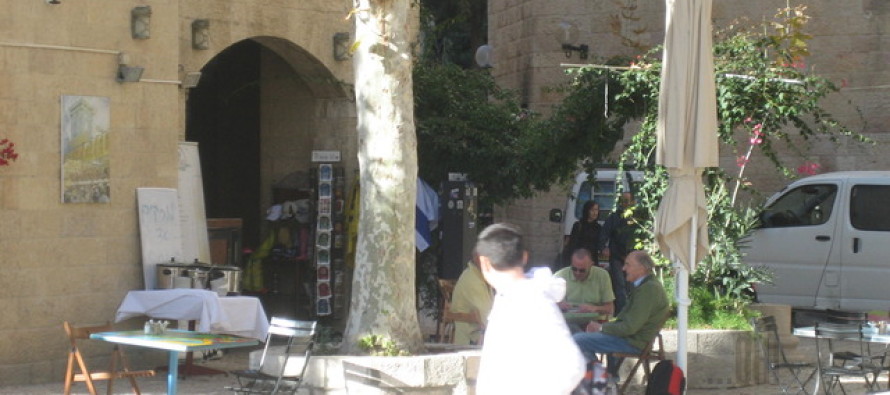
ISRAEL: The Hurva Synagogue + streets of Jewish Quarter

LA-JEW.com — The Hurva Synagogue, also known as Hurvat Rabbi Yehudah he-Hasid, is a historic synagogue located in the Jewish Quarter of the Old City of Jerusalem.
The synagogue was founded in the early 18th century by followers of Judah he-Hasid, but it was destroyed by Muslims a few years later in 1721. The plot lay in ruins for over 140 years and became known as the Ruin, or Hurva. In 1864, the Perushim rebuilt the synagogue, and although officially named the Beis Yaakov Synagogue, it retained its name as the Hurva. It became Jerusalem’s main Ashkenazic synagogue, until it too was reduced to rubble by the Arab Legion during the 1948 Arab–Israeli War.
After Israel conquered Jerusalem in 1967, a number of plans were submitted for the design of a new building. After years of deliberation and indecision, a commemorative arch was erected instead at the site in 1977, itself becoming a prominent landmark of the Jewish Quarter. The plan to rebuild the synagogue in its 19th-century style received approval by the Israeli Government in 2000, and the newly rebuilt synagogue was dedicated on March 15, 2010. The company involved with its reconstruction believes that restoring the synagogue to its former glory will once again allow it to serve as a centre for World Jewry.
The Hurva Synagogue today stands off a plaza in the centre of Jerusalem’s Jewish Quarter. Excavations carried out at the site in July and August 2003 revealed evidence from four main settlement periods: First Temple (800–600 BCE), Second Temple (100 CE), Byzantine and Ottoman. Three bedrock-hewn mikvahs (ritual baths) were uncovered there dating from the 1st century. The earliest tradition regarding the site is of a synagogue existing there at the time of the 2nd century sage Judah haNasi. By the 13th century, the area had become a courtyard, known as Der Ashkenaz (the Ashkenazic Compound), for the Ashkenazic community of Jerusalem. In 1488, Obadiah ben Abraham described a large courtyard containing many houses for exclusive use of the Ashkenazim, adjacent to a “synagogue built on pillars,” referring to the Ramban Synagogue. The Ramban Synagogue had been used jointly by both Ashkenazim and Sephardim until 1586, when the Ottoman authorities confiscated the building. Thereafter, the Ashkenazim established a synagogue within their own, adjacent courtyard.
The Hurva Synagogue was designed and constructed under the supervision of Assad Effendi, the sultan’s official architect. Built in neo-Byzantine style, it was supported by four massive pilasters at each corner over which soared a large dome. The construction of only one of these towers was completed. The other three were missing the upper level and the small dome that capped it. The facade was covered in finely hewn stone and incorporated 12.5 m (41 ft) high window arches. The height of the synagogue to the bottom of its dome was around 16 m (52 ft) and to the top of the dome it was 24 m (79 ft). Twelve windows were placed around the base of the dome, which was surrounded by a veranda, which offered a fine view of large parts of the Old City and the area around Jerusalem. Being one of the tallest structures in the Old City, it was visible for miles.
The plan to rebuild the synagogue in its original 19th century style received approval by the Israeli government in 2000. Jerusalem architect Nahum Meltzer, who proposed rebuilding the synagogue in its original Ottoman format, was given the commission. Meltzer stated that “both out of respect for the historical memory of the Jewish people and out of respect for the built-up area of the Old City, it is fitting for us to restore the lost glory and rebuild the Hurva Synagogue the way it was.” The state-funded Jewish Quarter Development Corporation originally convinced the Israeli government to allocate $6.2 million (NIS 24m), about 85% of the cost, for the reconstruction, with private donors contributing the remainder. In the end, the government only gave NIS 11m, with the remainder being donated by a Ukrainian Jewish businessman and philanthropist, Vadim Rabinovitch.
In 2002 the Israeli mint issued a set of medals featuring the synagogue to mark the beginning of the reconstruction project. Following comprehensive historic research, the reconstruction works began in 2005 and on February 15, 2007, Rabbi Simcha ha-Cohen Kook of Rehovot, was appointed as the rabbi of the Hurva, a move confirmed by leading rabbis, including Yosef Sholom Eliashiv. On April 15, 2008 a celebration marked the placing of the keystone in the synagogue’s dome.
The reconstructed Hurva was officially opened on March 15, 2010 in the presence of Israeli politicians and chief rabbis.























Look more: LA-JEW.com

 High quality & nature friendly luxury cosmetics from Scandinavia - ElishevaShoshana.com
High quality & nature friendly luxury cosmetics from Scandinavia - ElishevaShoshana.com

